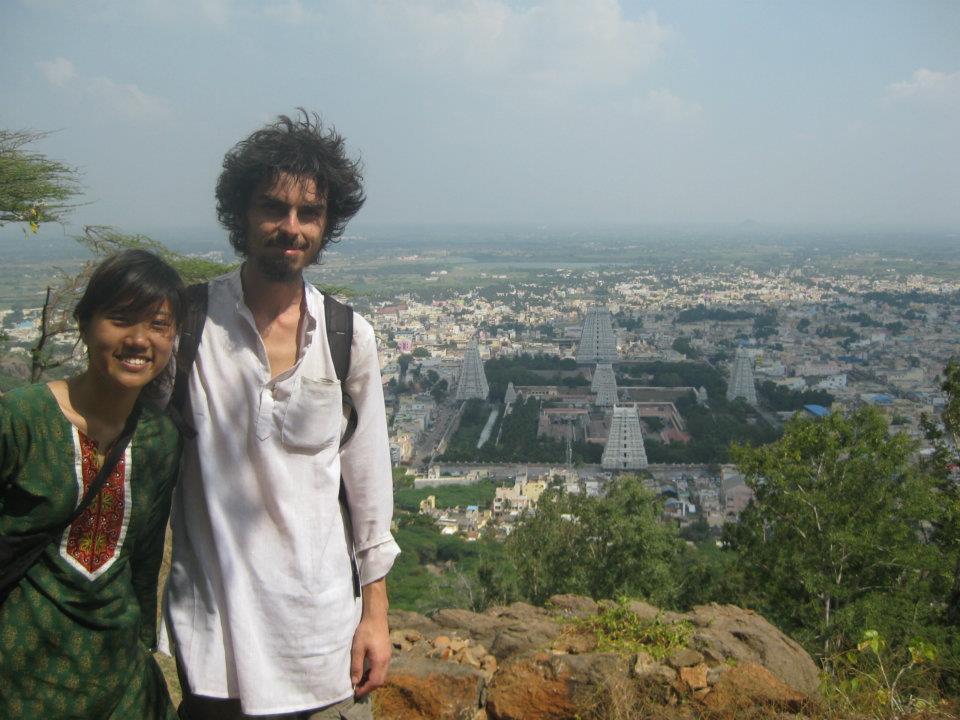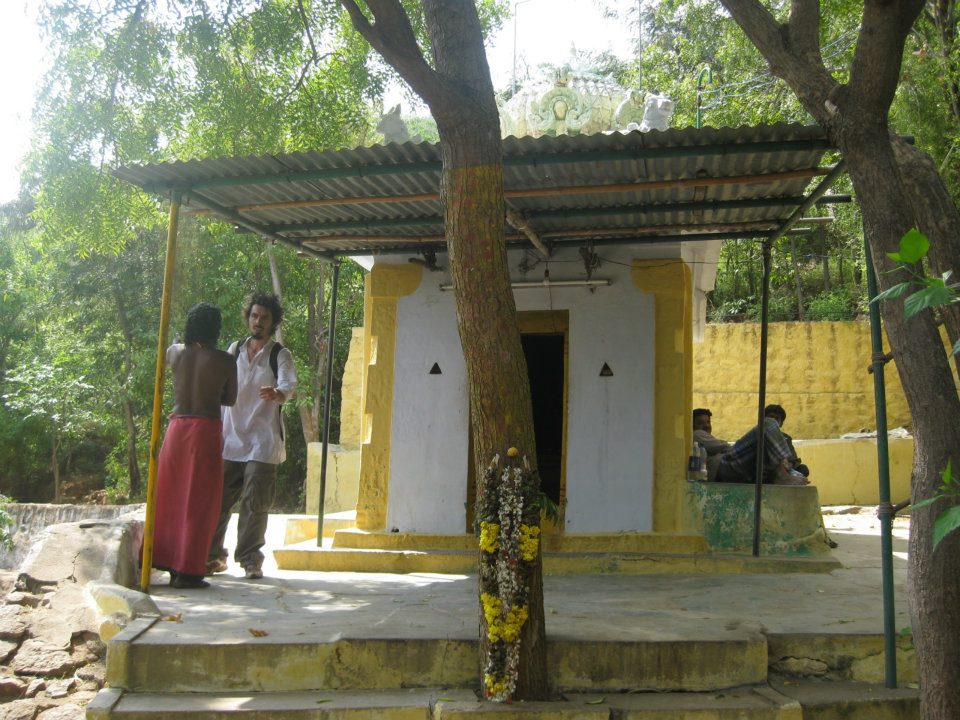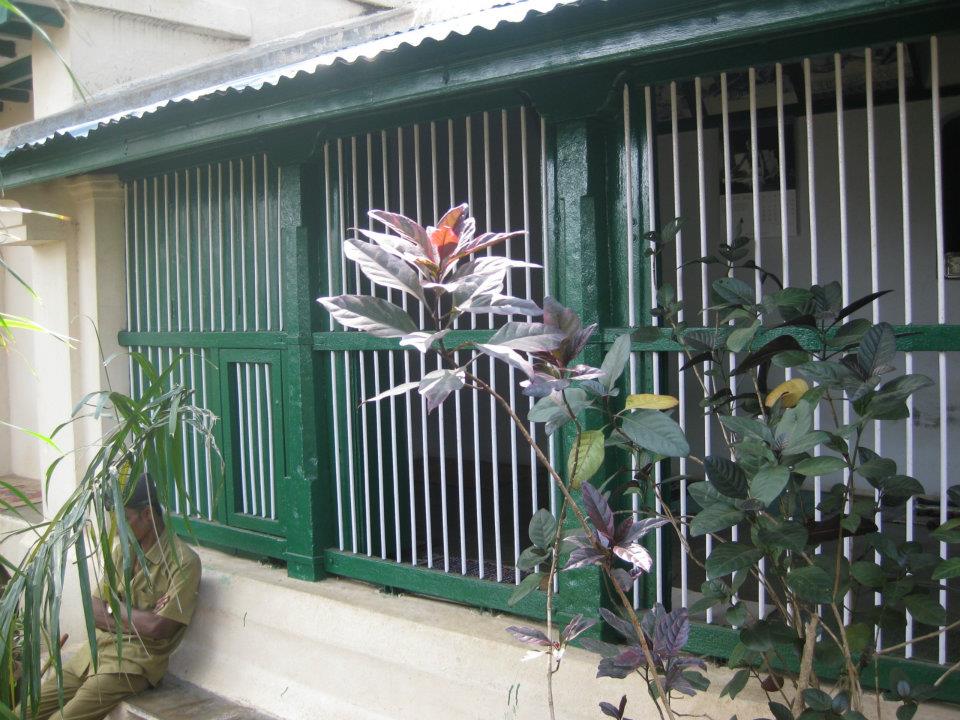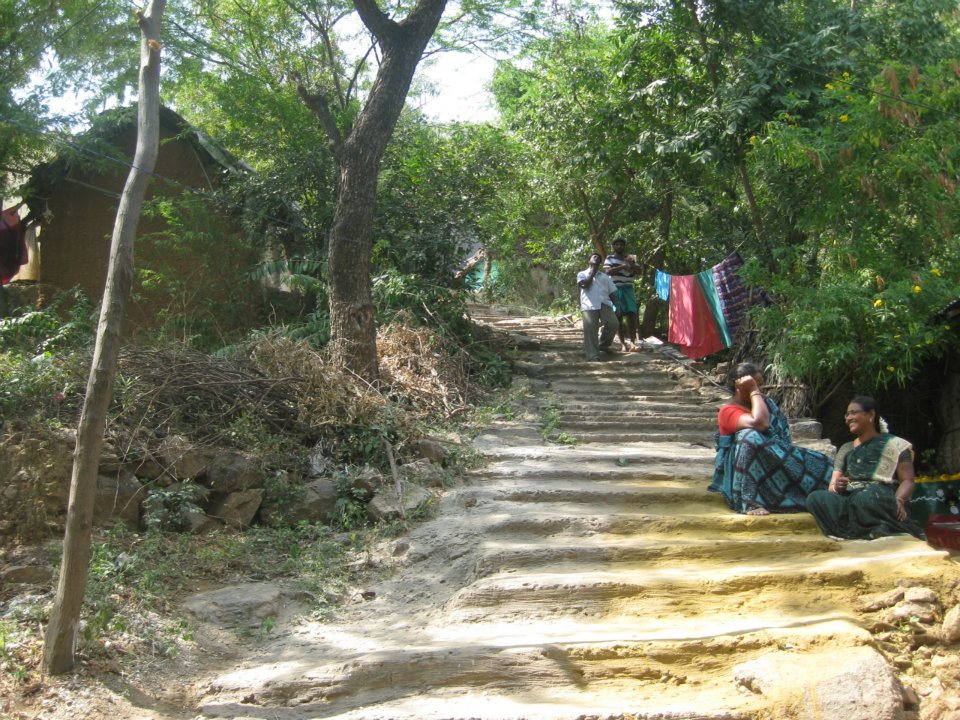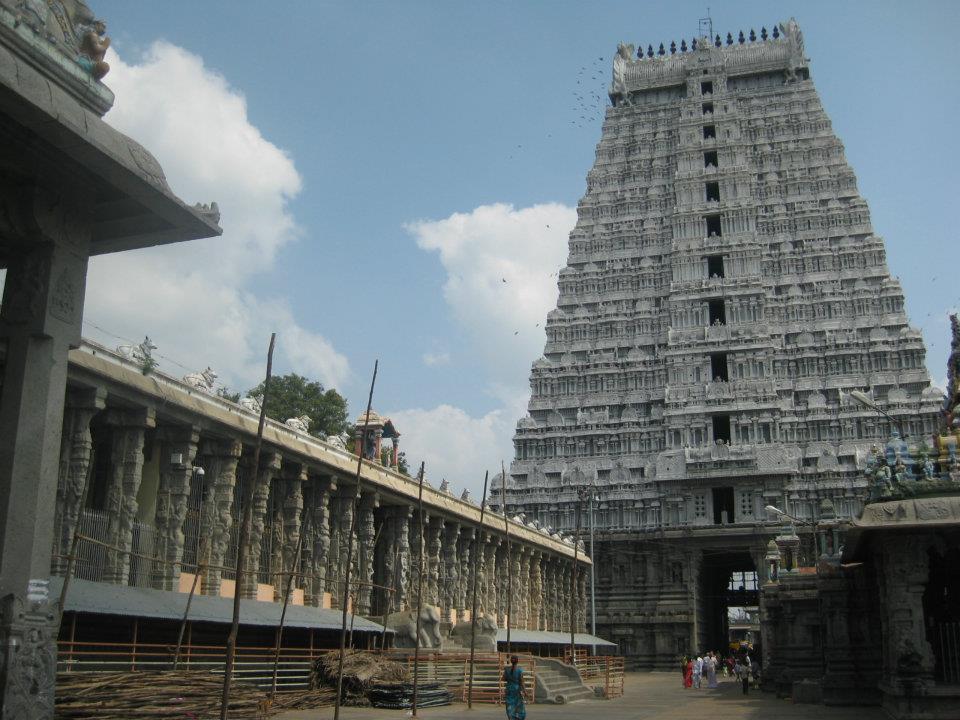
I am walking up a hill with Him, across some rickety stone steps. There is no one around, except the sound of the birds hiding in the trees from the hot afternoon sun. Beads of perspiration form under my nostrils, and I can fill my kurta sticking to my back. “This is the way to the ashram,” he said. I smiled and plodded on.
We stop for a while so that I can take photos of the surroundings. It’s really beautiful, seeing the four huge unpainted pillars of the temple from a higher ground.
Then he stops suddenly, puts his backpack on the ground, and the next minute before I can say anything, he takes his shirt off. I gap in surprise – of course, there is nothing much to see, only a bag of ribs and I bashfully turned away cos I spotted his boxers peeping out from his pants. It’s not the first time I have seen boxers, but it’s just Wrong to look. In my mind, I started wondering, “What the hell is he doing!” In India, I haven’t seen anyone taking out their shirt mid-walk. He is the first.
Thankfully, he stopped taking out more clothes, adjusted his pants to hide away remains of his boxers and we plodded on.
He is Francesco, a spiritual Italian whom I met at the Arunachaleswar Temple. It’s one of the biggest temples in the South and it’s famous for four of the largest unpainted gopurams (see picture). I also known him as, the Holy Man.
Francesco loves the South. Unlike many Westerners who have fled North to hide from the hot and humid weather, Francesco loves places where “there are no white men”. In fact, this dude was in Chennai for 10 days learning from a Yoga teacher, and may spend his remaining 20 days in the South. Respect.
Back at home when he is not practicing yoga or meditating, he is a puppeteer and a juggler. He has a girlfriend who is in Bangladesh working at an NGO. When he gets back, she help him with the music for the puppet show, while he moves the puppets around.
I tell Fransceco I am a student studying Business. It is easily that way because it’s hard to describe what public relations is. He turns around and asks me, “Is it boring?”
***
How I ended up in Tiruvannamalai is a hallmark of being crazy. We are all crazy. In different ways. I told a Brazilian professor in Delhi that I was going to Chennai. He then advised me to go to this town called Tiruvannamalai. He showed me a picture of the temple taken from the mountain from his iPhone 4, and my, it was nice. Hence I resolved to make a trip down, no matter how long it took.
And I did eventually arrived, 4.5 hours later after a long bus ride from Chennai. My legs were aching, sweat infused jeans stuck to my legs and I alighted feeling very lost. The people on the bus had asked me where I wanted to alight. Being the toot head I was, I forgot the name of the temple I was going to see, and could only repeat, Temple. Temple. Big Temple. That was my best.
In the end, thankfully only one temple exists in T.malai, and my fellow bus passengers offered to show me the way. One guy who spoke English was working nearby, and he pointed me to the right direction.
Now I was very keen to climb the mountain that my Brazilian friend did and take the same picture. But I had only 2-3 hours Tirvuvannamalai, because I had to travel another 4.5 hours if I wanted to make it back to Chennai to spend the night. I was disoriented, lost, and thoughts of that mountain just invaded my head.
Then just as I was about to enter the Arunachaleswar Temple, I spotted him. Wild hair, mustache and a long curly beard (probably haven’t shaved in a month) wearing a thin,white cotton Indian shirt and western pants with a pair of red sports shoes. In some sense, we had the same “style” cos I was wearing a kurta too paired with Western jeans and sneakers.
Apparently, our dear friend Francesco tried to enter the temple without taking of his shoes, and I told him so. He said, “Thank you,” and went to remove his shoes, while I carried on in.
Before I went in, I must mention that some cheaterbug tried to charge me RS500 for entrance (when it’s free fyi) – how I wished I told him to F*** off!
That is not the point. The point is soon after entered the temple, Francesco walks in too and said Thank you again. He asked me how to say thank you in my native language, and I told him xie xie. He mutters the two words diligently for a while, trying hard to remember them. Later he tells me it is his dream to learn how to say Thank You in all languages of the world.
So chancing upon a kind and friendly stranger, I asked him where are the nice temples and that Mountain that I wanted to climb. Now this Francesco brimming with the milk of human kindness, and sits down with me at some shady area of the temple and opens a map. He has bought it from the shop for RS10, and points to me all the areas of interest.
I tell him I only have two hours. He suggested that I go visit some Caves and then the Sri Ramanashram. Of course, I naturally do the opposite of what people tell me and insist on only going to my mountain. I thank him and said, “I will see how” and we part our separate ways.
Outside the temple, I try to ask for directions to this sacred mountain, and Holy Man appears again. This time he tells me he is going to the caves and the Sri Ramanashram and a little bit of mountain and ask if I will like to go.
“Of course lah, free tour guide.” An “aunty” voice rang out in my head, and that brings us back to the scene of our Franscesco taking out his shirt.
Now Francesco been in Tiruvannamalai for 3 days – quite an expert and knows where most things are. He told me he has been around, and has climbed the sacred mountain that I wanted to go.
“I find it funny,” he tells me. “These mountain is supposed to be scared to the people but they put some ghee on the floor and there is some rubbish lying on the ground. If this was my sacred mountain, I wouldn’t treat it like that.”
I will love to see the ghee like mountain, but unfortunately time does not prevail. Neither does my body’s tolerance to sunlight, after arriving from freezing Kashmir 2 days ago. After climbing some 20 steps to the caves, a confident thought was in my mind – fortunately I didn’t climb that mountain.
Thankfully, as we approached one of the caves, Francesco puts his shirt back on. It’s not really a cave but more of an ashram. Basically ashrams are quiet and dark halls for one to meditate and relax.
I went into this and everyone was quiet. It was cool, very dark and there was a smell of some incense floating by. It was so quiet that I could hear my watch tickling by one side. I look up and saw the photo of a thin Indian man in nothing but a lungyi staring at me. He resembled Gandhi in a way. I think he is the Guru. According to Lonely Planet, Sri Ramana passed away 20 years ago after meditating in that place for 50 years.
We sat down for five minutes. If that lasted longer I could have dozed off.
At the corner there lay an Ang Moh sitting with his back very straight up in a mediation pose. Quite cool I must say but strenuous? Wonder how they find inner peace like that.
Then we walked downslope to find the biggest ashram – the Sri Ramanashram. This had bigger meditation halls. There is a bigger courtyard, and I see Indian devotees clad in red. The men in red shirts while the women in red Saris. Francesco tells me that in the evening, the men and women will come together to sing a Vedic prayer. “It’s very nice, with their voices interlacing with one another.” he said.
Sri Ramana’s photo is plastered to most walls of the ashram. In the bookshop, I see his photo superimposed on different backgrounds to different books. One time he is on a stone rock. Another time he on a nice wooden chair. Another time he is perching on the temple grounds.
Francesco thinks of buying a book with the Vedic verse because he wants to learn Tamil – how cool is that? Tamil is widely available in Singapore, but I never dreamt of studying that language.
So, Francesco has an appointment with a Puri Walli to learn how to make Puris so we leave early. He in turn, will teach her how to make pizza, risotto and pasta.
At the shop, the Puri Walli too busy to teach him how to cook. She tells him she is very stressed as there are many customers,. Francesco jokes, telling her to take some time to meditate at the ashram. The Puri-walli asked if he would eat some Thalli, and he said he is fasting. “The Yogi people fast three days after the full moon. Up in the mountains, they are fasting,” he said.
I look around me and I see no locals fasting, perhaps this Yogi people are only high up. I have seen people starving in India, but fasting? That’s new.
Are your parents happy that you are here? I asked.
“I would love to carry my mother to India,” he said. “She is very spiritual and would like this place.” I am quite touched. Personally, I cannot imagine bringing, much less carrying my mother to India.
I guess I may never understand my Westerners are so keen to meditate in Ashrams. But as much as I am incline to dismiss this spiritual, ashram thing as nonsense, I acknowledge that people have different ways to calm themselves, look for their goals in life, and derive their lifelong dreams. If this way is harmless and it works, why not?
And for me, it’s not the cool marble floors of the ashram, but on these epic long bus rides that I find inner peace. As the bus rolls pass the fields with ladies in bright saris carrying colourful pots on their heads, or as we charge past a shepherd struggling to keep his herd of cows close to the side of the road, I feel a sense of peace.
